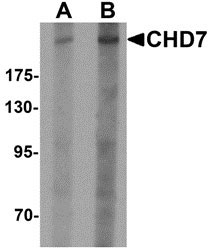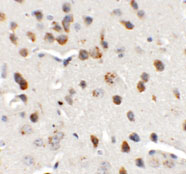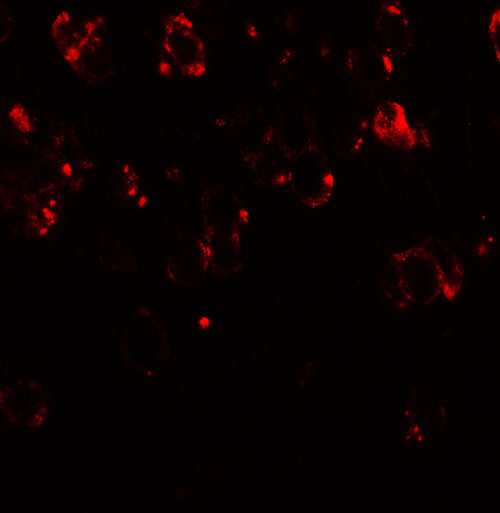CHD7 Antibody
- 产品详情
- 实验流程
- 背景知识
Application
| WB, IF, E, IHC-P |
|---|---|
| Primary Accession | Q9P2D1 |
| Other Accession | Q9P2D1, 54112403 |
| Reactivity | Human, Mouse |
| Host | Rabbit |
| Clonality | Polyclonal |
| Isotype | IgG |
| Calculated MW | 335927 Da |
| Concentration (mg/ml) | 1 mg/mL |
| Conjugate | Unconjugated |
| Application Notes | CHD7 antibody can be used for detection of CHD7 by Western blot at 1 - 2 µg/mL. Antibody can also be used for immunohistochemistry starting at 5 µg/mL. For immunofluorescence start at 20 µg/mL. |
| Gene ID | 55636 |
|---|---|
| Other Names | Chromodomain-helicase-DNA-binding protein 7, CHD-7, 3.6.4.12, ATP-dependent helicase CHD7, CHD7, KIAA1416 |
| Target/Specificity | CHD7; Multiple isoforms of CHD7 are known to exist. |
| Reconstitution & Storage | CHD7 antibody can be stored at 4℃ for three months and -20℃, stable for up to one year. As with all antibodies care should be taken to avoid repeated freeze thaw cycles. Antibodies should not be exposed to prolonged high temperatures. |
| Precautions | CHD7 Antibody is for research use only and not for use in diagnostic or therapeutic procedures. |
| Name | CHD7 |
|---|---|
| Synonyms | KIAA1416 |
| Function | ATP-dependent chromatin-remodeling factor, slides nucleosomes along DNA; nucleosome sliding requires ATP (PubMed:28533432). Probable transcription regulator. May be involved in the in 45S precursor rRNA production. |
| Cellular Location | [Isoform 1]: Nucleus |
| Tissue Location | Widely expressed in fetal and adult tissues. |
For Research Use Only. Not For Use In Diagnostic Procedures.
Provided below are standard protocols that you may find useful for product applications.
BACKGROUND
CHD7 Antibody: CHD proteins belong to a superfamily of proteins of ATP-dependent chromatin remodeling enzymes that have a unique combination of functional domains, including two N-terminal chromodomains, a SNF2-like ATPase/helicase domain and a DNA-binding domain. These proteins are thought to play a role in early embryonic development by affecting chromatin structure and gene expression. Mutations in one member of this family, CHD7, result in CHARGE syndrome. It colocalizes with embryonic stem (ES) cell master regulators OCT4/POU5F1, SOX2, and NANOG and is thought to modulate ES-specific gene transcription. Together with SOX2, CHD7 has been suggested to also regulate several human disease genes.
REFERENCES
Woodage T, Basrai MA, Baxevanis AD, et al. Characterization of the CHD family of proteins. Proc. Natl. Acad. Sci. USA 1997; 94:11472-7.
Cavalli G and Paro R. Chromo-domain proteins: linking chromatin structure to epigenetic regulation. Curr. Opin. Cell Biol. 1998; 10:354-60.
Vissers LE, van Ravenswaaj CM, Admiraal R, et al. Mutations in a new member of the chromodomain gene family cause CHARGE syndrome. Nat. Genet. 2004; 36:955-7.
Schnetz MP, Handoko L, Akhtar-Zaidi B, et al. CHD7 targets active gene enhancer elements to modulate ES cell-specific gene expression. PLoS Genet. 2010; 6:31001023.
终于等到您。ABCEPTA(百远生物)抗体产品。
点击下方“我要评价 ”按钮提交您的反馈信息,您的反馈和评价是我们最宝贵的财富之一,
我们将在1-3个工作日内处理您的反馈信息。
如有疑问,联系:0512-88856768 tech-china@abcepta.com.























 癌症的基本特征包括细胞增殖、血管生成、迁移、凋亡逃避机制和细胞永生等。找到癌症发生过程中这些通路的关键标记物和对应的抗体用于检测至关重要。
癌症的基本特征包括细胞增殖、血管生成、迁移、凋亡逃避机制和细胞永生等。找到癌症发生过程中这些通路的关键标记物和对应的抗体用于检测至关重要。 为您推荐一个泛素化位点预测神器——泛素化分析工具,可以为您的蛋白的泛素化位点作出预测和评分。
为您推荐一个泛素化位点预测神器——泛素化分析工具,可以为您的蛋白的泛素化位点作出预测和评分。 细胞自噬受体图形绘图工具为你的蛋白的细胞受体结合位点作出预测和评分,识别结合到自噬通路中的蛋白是非常重要的,便于让我们理解自噬在正常生理、病理过程中的作用,如发育、细胞分化、神经退化性疾病、压力条件下、感染和癌症。
细胞自噬受体图形绘图工具为你的蛋白的细胞受体结合位点作出预测和评分,识别结合到自噬通路中的蛋白是非常重要的,便于让我们理解自噬在正常生理、病理过程中的作用,如发育、细胞分化、神经退化性疾病、压力条件下、感染和癌症。








